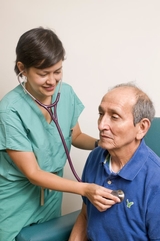
AUDIENCE: This guidance is targeted to facilities that provide residential care services to the elderly.
BACKGROUND: COVID-19 is a new respiratory disease caused by the SARS-CoV-2 virus. Illness severity ranges from asymptomatic to life-threatening. Signs and symptoms of infection include fever, cough, and difficultybreathing. Fatigue, myalgia, sore throat, headache, and, less frequently, gastrointestinal symptoms such as nausea, vomiting, or diarrhea have also been reported in some patients. Based on the limited available data, older adults and those with chronic medical conditions are at highest risk for severe illness.
At present there is no vaccine to prevent COVID-19 and no antiviral medication that can be used for post-exposure prophylaxis of exposed patients. Prevention and control efforts must therefore rely on other measures.
COVID-19 may be introduced into residential care facilities by newly admitted residents, staff, or visitors. Spread can occur between and among residents, staff, and visitors.
General Measures to Be Implemented Now
- Restrict ill visitors. Post signs at the entrance instructing visitors not to visit if they have symptoms of respiratory infection.
- Restrict employees from working while ill.
- Staff with respiratory or influenza-like illness should not work until their symptoms have subsided for 48 hours consecutively.
- Ensure that sick leave policies allow employees to stay home if they have symptoms of infection.
- Staff developing symptoms while at work should immediately don a facemask, notify management, and leave work.
- Encourage hand hygiene and respiratory etiquette by all residents, visitors, and employees:
- Employees should review and follow recommendations for hand hygiene before and after contact with residents, and after contact with contaminated surfaces or equipment.
- Encourage handwashing and/or use of alcohol-based hand sanitizer; place hand sanitizer inside and outside residents’ rooms; have sinks available with soap and paper towels for hand washing.
- Alcohol-based hand sanitizer is currently in short supply; therefore, if you do not have a supply of alcohol-based hand sanitizer, revert to hand washing as frequently as possible.
- Post signs encouraging hand hygiene and respiratory etiquette. A hand hygiene sign with multiple translations is available for download at http://eziz.org/assets/docs/IMM-825.pdf
- Enhanced cleaning of common areas.
- Make sure all surfaces are wiped with an EPA-approved disinfectant at least daily and as needed, especially “high-touch” surfaces such as doorknobs, handrails, etc.he EPA’s list of approved products is here: https://www.epa.gov/sites/production/files/2020-03/documents/sars-cov-2-list_03-03-2020.pdf
- Stay up to date with local and state COVID-19 activity and developments (in addition to CDC):
Symptomatic Residents:
- Contact SMCH COVID-19 Communicable Disease Unit to discuss the case at (650) 573-2346 (please do not share this number with the public). All suspected cases are required to be reported to San Mateo County Health.
Further Steps Should COVID-19 Infection Be Confirmed:
- Conduct further management in consultation with San Mateo County Health Communicable Disease Unit to limit the likelihood of transmission to others in the facility. The following actions will be required in consultation with County Health:
- Restriction of admissions to the facility and transfers to any unit with symptomatic residents
- Cancellation of group activities; all meals to be served in resident rooms
- Restriction of admission of all visitors, including children, to the facility
- Recording a log of all persons who care for or enter the room of the ill resident
- Monitoring of employees who were in contact with the case per the CDC Interim U.S. Guidance for Risk Assessment and Public Health Management of Healthcare Personnel with Potential Exposure in a Healthcare Setting to Patients with COVID-19: https://www.cdc.gov/coronavirus/2019-ncov/hcp/guidance-risk-assesment-hcp.html
- Notification of external facilities prior to transferring any ill resident for further care.
- Additional control measures and duration of implementation will be determined in consultation with County Health.